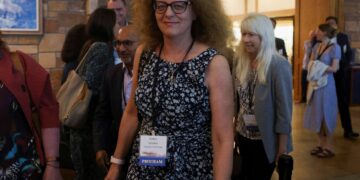President Donald Trump’s victory lap after the stock market mostly rebounded Wednesday shows he’s an economic arsonist who likes to cosplay as a firefighter.
After Trump announced his so-called Liberation Day tariffs on scores of countries last week, global markets tanked to levels previously seen at the onset of major economic recessions. Americans (most of whom don’t have pensions) saw their retirement accounts ravaged. And companies laid off thousands of manufacturing workers.
But Wednesday — shortly after posting to his social media site that “this is a great time to buy!” — Trump abruptly reversed course and announced that those tariffs would be paused for 90 days.
By any metric, the stock market is still down big since Trump took office.
However, he raised tariffs on China even further — to a whopping 125% — and left in place a universal 10% tariff on other countries, as well the 25% tariffs on Canada and Mexico. Still, the announced “pause” was encouraging enough news that the stock market had a historic one-day surge. Even so, since Trump launched his trade war of choice, the market is still down sharply.
Ignoring that context, Trump, in the Oval Office on Wednesday, bragged to the assembled press corps about “the biggest increase in the history of the stock market. That’s pretty good.” And yet, as The New York Times reported:
“Even after the S&P 500’s sharp rise on Wednesday, the index remains 11.2 percent below its most recent high, in February. The tech-heavy Nasdaq Composite index rose 12.2 percent but is still roughly 15 percent below its December high. The Russell 2000 index of smaller companies more exposed to the outlook of the economy is roughly 22 percent below its November high. It remains the S&P 500’s worst start to a presidential term since the dot-com bubble was bursting at the beginning of 2001.”
So why was Trump launching a global trade war — which, even if he’s just bluffing, essentially ends America’s role as the leader of the global free market system — in the first place?
Some of his most hard-core supporters offered contradictory reasons, all of them based on the premise that Trump was standing up for America against a world order that had somehow bullied the world’s largest economy into economic calamity.
They argued Trump was fulfilling his promise to make the U.S. a manufacturing hub again but also to make free trade fairer for the U.S. — which Trump believes is getting ripped off by the rest of the world because of trade deficits. The latter argument ignores the fact that such deficits afford Americans far greater purchasing power than they’d have in a country walled off from trade with the rest of the world. And how did the president calculate those so-called reciprocal tariff rates, anyway? (Rather unscientifically, it turns out.)
Trump’s commerce secretary, Howard Lutnick, had said last week, “I don’t think there’s any chance that President Trump’s going to back off his tariffs,” and his trade adviser, Peter Navarro, insisted in an op-ed in The Financial Times, “This is not a negotiation.” At the same time, one of Trump’s most passionate and wealthy supporters, Bill Ackman, warned that the president’s actions could create a “self-induced, economic nuclear winter” and seemed to put the blame for the ill-advised decision on the president’s advisers.
Ultimately, Trump’s ‘Art of the Deal’ myth — created by a ghostwriter who lives every day of his life in regret — will endure for his most steadfast supporters.
But once Trump announced the 90-day pause Wednesday — voila! — that same billionaire praised the president for a “brilliantly executed” move, adding it was “Textbook, Art of the Deal.” Trump’s deputy chief of staff for policy, Stephen Miller, posted to X, “You have been watching the greatest economic master strategy from an American President in history.” Trump himself claimed on Truth Social that “more than 75 countries” had reached out seeking to negotiate, though as of Wednesday night the White House hadn’t responded to NBC News’ requests for a list of those countries.
Despite the flailing attempts to spin this entire episode in a positive light, there’s no escaping certain facts.
One, by any metric, the stock market is still down big since Trump took office.
Two, both U.S. and foreign companies still have no reason to feel confident the Trump administration is a stable, good-faith actor. If anything, the bait-and-switch will make them less likely to invest in America.
And ultimately, Trump’s “Art of the Deal” myth — created by a ghostwriter who lives every day of his life in regret — will endure for his most steadfast supporters, who would believe him if he told them he made it rain in the desert.


















